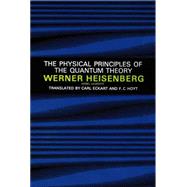The contributions of few contemporary scientists have been as far reaching in their effects as those of Nobel Laureate Werner Heisenberg. His matrix theory is one of the bases of modern quantum mechanics, while his "uncertainty principle" has altered our whole philosophy of science.
In this classic, based on lectures delivered at the University of Chicago, Heisenberg presents a complete physical picture of quantum theory. He covers not only his own contributions, but also those of Bohr, Dirac, Bose, de Broglie, Fermi, Einstein, Pauli, Schrodinger, Somerfield, Rupp, ·Wilson, Germer, and others in a text written for the physical scientist who is not a specialist in quantum theory or in modern mathematics.
Partial contents: introduction (theory and experiment, fundamental concepts); critique of physical concepts of the corpuscular theory (uncertainty relations and their illustration); critique of the physical concepts of the wave theory (uncertainty relations for waves, discussion of an actual measurement of the electromagnetic field); statistical interpretation of quantum theory (mathematical considerations, interference of probabilities, Bohr's complementarity); discussion of important experiments (C. T. R. Wilson, diffraction , Einstein-Rupp, emission, absorption and dispersion of radiation, interference and conservation laws, Compton effect, radiation fluctuation phenomena, relativistic formulation of the quantum theory).
An 80-page appendix on the mathematical apparatus of the quantum theory is provided for the specialist.

The Physical Principles of the Quantum Theory
by Heisenberg, Werner-

This Item Qualifies for Free Shipping!*
*Excludes marketplace orders.
Buy New
Rent Book
Rent Digital
Used Book
We're Sorry
Sold Out
How Marketplace Works:
- This item is offered by an independent seller and not shipped from our warehouse
- Item details like edition and cover design may differ from our description; see seller's comments before ordering.
- Sellers much confirm and ship within two business days; otherwise, the order will be cancelled and refunded.
- Marketplace purchases cannot be returned to eCampus.com. Contact the seller directly for inquiries; if no response within two days, contact customer service.
- Additional shipping costs apply to Marketplace purchases. Review shipping costs at checkout.
Summary
Table of Contents
1. Theory and Experiment
2. The Fundamental Concepts of Quantum Theory
a) Wilson Photographs
b) "Diffraction of Matter Waves (Davisson and Germer, Thomson, Rupp)"
c) The Diffraction of X-Rays
d) The Compton-Simon Experiment
e) The Collision Experiments of Franck and Hertz
II. CRITIQUE OF THE PHYSICAL CONCEPTS OF THE CORPUSCULAR THEORY
1. The Uncertainty Relations
2. Illustrations of the Uncertainty Relations
a) Determination of the Position of a Free Particle
b) Measurement of the Velocity or Momentum of a Free Particle
c) Bound Electrons
d) Energy Measurements
III. CRITIQUE OF THE PHYSICAL CONCEPTS OF THE WAVE THEORY
1. The Uncertainty Relations for Waves
2. Discussion of an Actual Measurement of the Electromagnetic Field
IV. THE STATISTICAL INTERPRETATION OF QUANTUM THEORY
1. Mathematical Considerations
2. Interference of Probabilities
3. Bohr's Concept of Complementarity
V. DISCUSSION OF IMPORTANT EXPERIMENTS
1. The C. T. R. Wilson Experiments
2. Diffraction Experiments
3. The Experiment of Einstein and Rupp
4. "Emission, Absorption, and Dispersion of Radiation"
a) Application of the Conservation Laws
b) Correspondence Principle and the Method of Virtual Charges
c) The Complete Treatment of Radiation and Matter
5. Interference and the Conservation Laws
6. The Compton Effect and the Compton-Simon Experiment
7. Radiation Fluctuation Phenomena
8. Relativistic Formulation of the Quantum Theory
APPENDIX: THE MATHEMATICAL APPARATUS OF THE QUANTUM THEORY
1. The Corpuscular Concept of Matter
2. The Transformation Theory
3. The Schršdinger Equation
4. The Perturbation Method
5. Resonance between Two Atoms: the Physical Interpretation of the Transformation Matrices
6. The Corpuscular Concept for Radiation
7. Quantum Statistics
8. The Wave Concept for Matter and Radiation: Classical Theory
9. Quantum Theory of Wave Fields
10. Application to Waves of Negative Charge
11. Proof of the Mathematical Equivalence of the Quantum Theory of Particles and of Waves
12. Application to the Theory of Radiation
INDEX
An electronic version of this book is available through VitalSource.
This book is viewable on PC, Mac, iPhone, iPad, iPod Touch, and most smartphones.
By purchasing, you will be able to view this book online, as well as download it, for the chosen number of days.
Digital License
You are licensing a digital product for a set duration. Durations are set forth in the product description, with "Lifetime" typically meaning five (5) years of online access and permanent download to a supported device. All licenses are non-transferable.
More details can be found here.
A downloadable version of this book is available through the eCampus Reader or compatible Adobe readers.
Applications are available on iOS, Android, PC, Mac, and Windows Mobile platforms.
Please view the compatibility matrix prior to purchase.